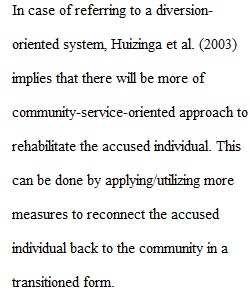


Q Reminder: Initial Discussion Board posts due by Friday, responses due by Tuesday Students will be expected to post their first initial discussion board posting by Friday of each week. Discussion posts will be graded and late submissions will be assigned a late penalty in accordance with the late penalty policy found in the syllabus. NOTE: All submission posting times are based on midnight Central Time. Students are expected to post their responses to peers by Tuesday. NOTE: All submission posting times are based on midnight Central Time. Primary Task Response: Within the Discussion Board area, write 400–600 words that respond to the following questions with your thoughts, ideas, and comments. This will be the foundation for future discussions by your classmates. Be substantive and clear, and use examples to reinforce your ideas. The objective of this assignment is to enable you to demonstrate your understanding of the relationship between justice policy and case processing and management using an example from the juvenile justice system. In 2004, researchers at the University of Colorado and the University of Bremen (Germany) reported on a cross-national study funded by a grant from the U.S. Department of Justice. (This free research report can be accessed here: and downloaded in PDF format). NOTE: if for whatever reason this link does not work, you can also go to http://www.ncjrs.gov/, click on "Juvenile Justice" and in the keyword search within topic box, enter the grant number 205001 to download a PDF version of the report and also view the abstract and the agency summary. According to this report, there are some key differences between these two jurisdictions in terms of how juveniles are treated, with the system in Bremen being more lenient and “diversion-oriented" and the one in Colorado being more “punitive.” In Colorado, offenders can be arrested at a much earlier age than in Bremen and are more often processed via juvenile court and detention, whereas in Bremen, dismissal of cases or diversion from formal court processing occurs in the vast majority of cases. Although the findings must be tempered by the limitations to the research discussed in the report, the authors nevertheless offer conclusions that should be considered by court administrators, including these: (1) arrest and imposition of sanctions are generally ineffective strategies and (2) policymakers should examine whether increasing the levels of severity in juvenile sanctions is an effective approach to reducing subsequent delinquency. In this Discussion Board assignment, you have several tasks: • First, demonstrate your understanding of what the authors mean by “diversion-oriented system” versus “punitive- or punishment-oriented system." • Second, offer your perspective on whether a shift toward a “diversion” and away from a “punishment” (arrest, court processing, court trial, possible detention) model for dealing with juvenile offenders would be effective in the U.S. juvenile justice system. • Third, find an example of a diversion-oriented model that has been applied by a U.S. state or county juvenile court system, and describe its main features. • Finally, suggest how you think a diversion-oriented shift might impact case processing and caseflow management. Responses to Other Students: Respond to at least 2 of your fellow classmates with at least a 100-word reply about their Primary Task Response regarding items you found to be compelling and enlightening. To help you with your discussion, please consider the following questions: • What did you learn from your classmate's posting? • What additional questions do you have after reading the posting? • What clarification do you need regarding the posting? • What differences or similarities do you see between your posting and other classmates' postings? For assistance with your assignment, please use your text, Web resources, and all course materials.
View Related Questions